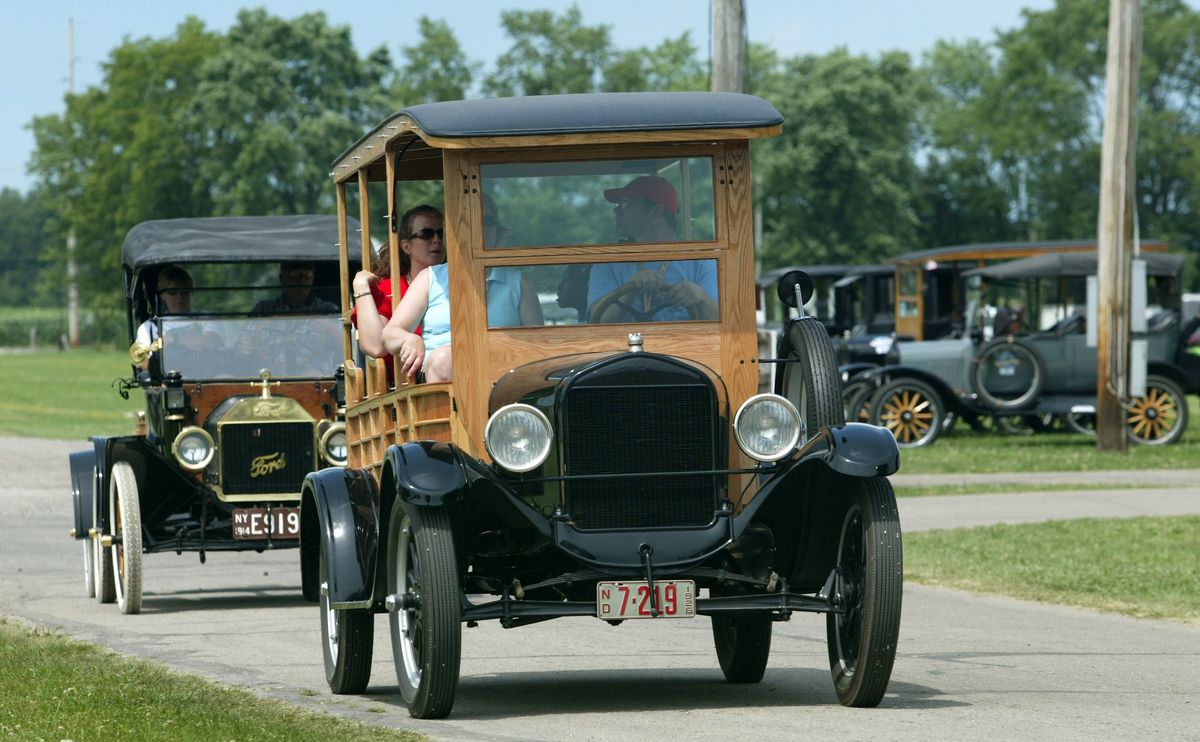Ford’s T Party
Aficionados gather to celebrate the 100th birthday of the car that opened the country to ordinary people

RICHMOND, Ind. – Ford Motor Co. is marking the 100th anniversary of the Model T, the first low-priced car that introduced motoring to the masses, at a time when Americans are cringing at the cost of filling their gas tanks and the U.S. auto industry is struggling with plant closings and layoffs.
But a weeklong celebration of the Model T promises to offer some nostalgic balm.
About 750 of the iconic vehicles were on display Monday in what is being called the largest gathering of Model Ts since they left the factory.
“I’m thrilled to be with the keepers of my great-grandfather’s legacy,” Edsel Ford II, referring to company founder Henry Ford, told those attending the opening banquet.
His voice breaking with emotion at one point, Ford said it was the spirit of the Model T that made the vehicle so successful.
“It was a product that delivered freedom,” he said. “You are the guardians of the spirit that got the whole thing going. You are the keepers of the flame. As long as we have people who love the Model T, we will never forget what brought us here.”
The gathering transformed the Wayne County Fairgrounds into what looked like a movie set for a motion picture depicting life in the early 1900s. Drivers created Model T traffic jams as they picked their way among barns, giving a friendly “AH-OO-GAH” honk of their horns.
Geff Bland, 42, drove his 1915 Model T to the celebration from his home in Springfield, Mo. It took three days.
Bland began driving his father’s Model T in Mississippi when he was 12 years old.
“We lived in a rural town where I could drive the car and nobody said anything,” he recalled. “I used to take it out on the gravel roads. I could hear the engine echo off the pine trees at night, and I liked that.”
Richard Wells, 71, of Lucasville, Ohio, was resting in a lawn chair next to his blue 1926 Model T.
“You get out and drive slow,” Wells said. “It’s life in the slow lane.”
Jay Klehfoth, CEO of the Model T Ford Club of America based in nearby Centerville, said owners of the Model T are like a big extended family.
“Sometimes we refer to ourselves as the similarly afflicted,” Klehfoth said. “We recognize we are only temporary custodians of these rolling pieces of history. We’re doing our little piece to try to keep this segment of history alive.”
Roger Peterson, 71, of Greeneville, Tenn., has owned 11 Model Ts over the years. He bought his first – a 1923 speedster – when he lived in Marshfield, Mass.
“You don’t own just one Model T,” Peterson said. “You buy another one and another one and another one.”
John Heitmann, a history professor at the University of Dayton who has taught classes on automobile history and its impact on American life, said the Model T is one of the most historically significant cars of the 20th century and maybe the single most important American car.
Henry Ford realized there was a big market for cars – not just for the wealthy – and that people would keep buying them, Heitmann said.
“It was kind of the common car for the common person,” he said.
A century later, Ford and other Detroit automakers are struggling to keep up with consumer demands. Buyers are shunning trucks and sport utility vehicles for more fuel-efficient models, and high gas prices and a sluggish economy are keeping sales low.
All major automakers but Honda Motor Co. reported steep sales declines for June. Ford’s sales tumbled 27.9 percent from June 2007.
The Model T gathering in Richmond aims to be more than just an antique car show but a reminder of Ford’s groundbreaking automobile.
The first production Model T Ford was assembled in Detroit on Oct. 1, 1908. With the development of the sturdy low-priced car, Henry Ford made his company the biggest in the industry, according to the Henry Ford Museum.
In a span of 19 years, Ford would build 15 million cars with the Model T engine.
The Model T, nicknamed the “Tin Lizzie,” was probably the most important vehicle in causing social change in America, Heitmann said. It helped transform the nation’s cities, enabling residents to move farther away from trolley lines and creating the first ring of suburbs, he said.
“The move out of the city began with the Model T and other vehicles, particularly after World War I,” he said.
Heitmann said the Model T also was embraced by farmers and rural Americans.
“It had a very high ground clearance. It was easy to repair. It was so inexpensive that isolation on the American farm came to an end,” he said.
Heitmann said Ford raised wages to attract and keep workers at his factories, and employed immigrants and minorities.